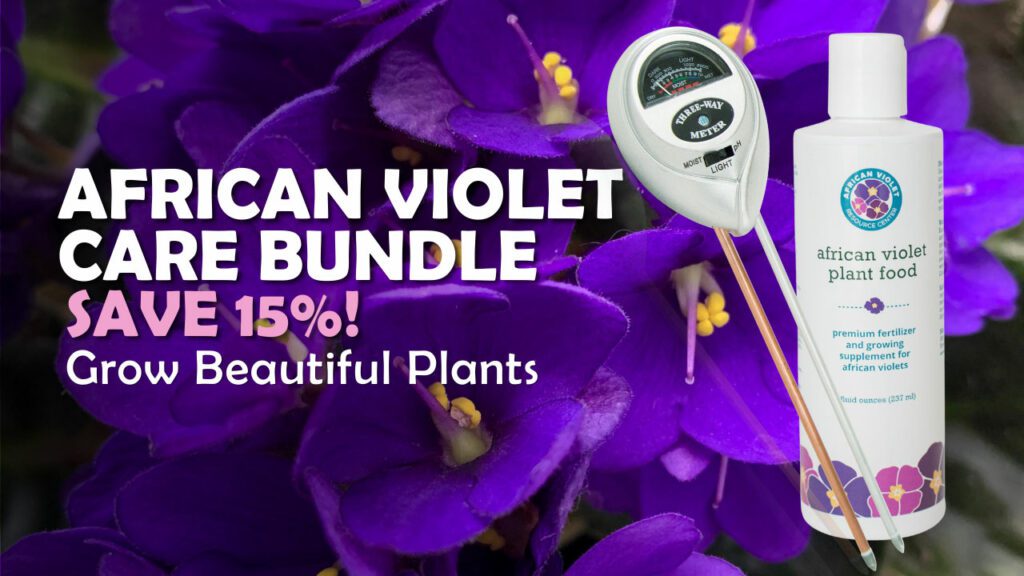African violets are an incredibly popular houseplant for a reason. They come in a wide range of beautiful colors and are easy houseplants to care for, making them perfect for new plant lovers as well as more experienced ones. African violets bloom up to 10 months of the year, which leaves other favored houseplants looking like slackers.
However, it can be very frustrating when African violet blooms start to die. What causes African violets to stop blooming? What can you do to help your African violets bloom again?
Even though African violets are hardy, this does not mean that they bloom constantly without any attention. Sure, they can survive a little neglect, but they need consistent care in order to thrive.
Keep reading to find out how to make your African violet bloom as much as possible.
How to Take Care of African Violets
African violets are so loved in part because they are so easy to care for. Should you occasionally forget that you are supposed to be watering your plants regularly (not that you would do that, of course), African violets are more likely to still be perky when most other common houseplants have already given up.
African violets can survive in less-than-ideal conditions. However, if you want blooms almost all year long, you have to take more care of them.
Here’s what they require.
Soil
Although African violets are easy to care for, soil is the one area where African violets are the most particular. Regular houseplant potting soil does not work for African violets.
African violets are native to environments in East Africa where they grow with little soil. For this reason, their roots need soil that allows for airflow while still providing consistent moisture.
Either buy commercial potting soil made for African violets or make your own soil. To allow for drainage while still retaining moisture, most mixes for African violets should contain both moss and vermiculite.
For further reading, see Making Sense of African Potting Mix (and How to Make it Too)
Water
Creating a houseplant watering schedule can be tricky because many factors affect how much water a plant needs. The best way to tell if an African violet needs water is to observe the plant and the soil.
Check the soil by sticking your finger ½ inch deep into the potting mixture. If things feel dry, then it is time to water. If the potting mix is still damp, it is not time to water yet. African violets can get root rot if they sit in water for too long, so try not to overwater.
Another signal that your African violets need water is dull or limp leaves in the center of the plant. If you see this happen, water right away.
Most African violet owners choose to bottom water their African violets. To do this, fill a tray or bowl with water and place the entire pot in the water. Allow the soil to absorb water for 20 minutes, then remove the pot. You’ll still want to top water about once a month to flush out any excess materials that have built up in the soil. Bottom watering helps prevent crown rot. Personally, I prefer bottom watering for African violets because I find that African violet soil mix drains water too quickly unless I bottom water.
You might have heard that tap water can damage African violets. In most communities, this is not the case and you can use regular tap water with no issues. Some tap water does contain chemicals that are useful for purifying water but have a negative effect on African violets. Most of the time this is not a problem.
Sunlight
The right soil and moisture conditions are essential for African violets to grow, but sunlight is the factor that most affects how African violets bloom. African violets need access to bright light in order to bloom. Without enough life, they will have healthy, green leaves but no flowers.
Finding the perfect spot for African violets can be tricky. During the summer, keep your African violets away from direct light in the middle of the day. Find a spot where they get morning or afternoon sun instead. During the winter, keep your African violets closer to windows that face south or west to get access to more sunlight.
The correct amount of sunlight is the key to keeping your African violets blooming most months of the year.
If you have moved into a new space and have multiple African violets, the easiest way to find the best spot for your collection is to split them up to begin with and place them in different areas. After a few months, move them all to whichever spot seems to be the most successful.
If you have just gotten your first African violet, know that it may take some maneuvering before you find the perfect spot. Don’t give up too soon because once your African violet is happy, you’ll be rewarded with blooms for long enough to make you forget about the rocky start.
Fertilizer
You might be wondering whether or not you need fertilizer for your African violets.
The answer is yes.
Unlike outdoor plants, houseplants rely on you to provide the extra nutrients that they need. Even if you use a potting soil mix with fertilizer, you will eventually need to provide supplemental fertilizer once the plant uses up the available nutrients.
Fertilizer is necessary to help keep African violets happy and blooming. If they do not have all the nutrients they need, they will put their energy toward just surviving rather than flowering.
Pick a balanced fertilizer where the ratios of nitrogen, phosphorus, and potassium are the same. Dilute the formula and apply it regularly to your African violets. Because they typically grow in small containers, you use up the available nutrients quickly.
Be careful not to go overboard with fertilizer, though. Too much fertilizer can damage your plant’s roots.
To keep your fertilizing routine simple, consider using a liquid formula specifically created for African violets. The advantage to using a liquid formula is that you can easily dilute them and mix them in water to use whenever you normally water your African violets. If the process for fertilizing is easy, you’re much more likely to remember to fertilize as often as you need to.
Common Reasons African Violets Won’t Bloom
Sometimes even when you do your best to provide optimal care for your African violets, you notice that your African violet blooms are wilting. It can be disappointing to see the color flowers turning brown and new flowers refusing to bloom.
The good news is that, unless you’ve managed to completely kill your African violets, then your African violets will probably bloom again once you’ve solved whatever the issue is.
Problem #1: You are overwatering or underwatering your African violets.
Sometimes, we make mistakes with watering. Taking steps to solve the problem as soon as you notice it allows your African violet to get back on track with blooming sooner.
Overwatering is generally the most common problem. If you suspect that you have overwatered your African violet more than a few times, check the roots. Roots with root rot feel soft and appear brown or black.
Trim off any damaged roots. Keep all the roots that are still light-colored intact. Use a root supplement to help treat and prevent any signs of root rot.
Your African violets should rebound in time. Just make sure that you are watering less often and that your African violet container is not allowing water to pool up in the bottom.
Underwatering is usually less of a problem. If you forget to water your African violets, the flowers will wilt, but you’re more likely to be aware that’s the issue because you will know that you can’t remember the last time you watered them.
Begin watering your African violets regularly again if this happens. They will sulk for a little while, but they should begin blooming again. I’m slightly forgetful about watering plants in certain areas of my house, so I’m speaking from experience on the topic of underwatering.
Problem #2: Your African violets are getting too cold during the winter.
African violets typically bloom most months of the year. However, if you have them placed in a window, the temperature next to the winter may be much colder than in the rest of your house. African violets need to stay in a temperature range of 65 to 80 degrees Fahrenheit to bloom consistently.
If you live in a moderate climate, as I do, you probably won’t have an issue with this, but if you live in a colder climate (AKA you frequently drop below freezing for long periods during the winter), then you might need to move your African violets farther away from windows.
Of course, moving your African violets a little bit away from sunlight can also affect blooms. So you may still see an interruption in flowering during the coldest months. That being said, you could use grow lights to supplement the amount of light your African violets get during these months.
My preferred plan is to live somewhere with a moderate climate because, like my houseplants, I do not enjoy being cold. If you enjoy being a human popsicle for part of the year, though, moving your African violets from next to the window and possibly using a grow light will allow you to have flowering African violets.
Problem #3: Your container is too big for your African violets.
It may sound a little strange that having too large of a pot would be a problem for African violets, but this can be an issue. When you place African violets in a pot with too much space, they devote more energy to growing roots rather than developing blooms.
You should repot your African violets once or twice a year. This means that you should remove the plant from its pot and replace the soil with fresh potting mix. However, you should place the African violet back into the same pot or at least the same size pot unless the roots have become root-bound.
Don’t be in a rush to move African violets to a new pot. They can handle being in small containers. You only need to move them to larger pots when the roots begin to circle around the inside edge of their pots. Otherwise, just give them a soil refresh when you repot.
Problem #4: Your humidity levels are too low for your African violets.
This fourth problem is rarely an issue because African violets thrive in the humidity levels of a typical home. The best humidity levels for African violets are between 40 and 60 percent humidity, which also happens to be the preferred level of humidity in most homes.
If your indoor humidity level typically drops below 40%, your African violets may need additional humidity to continue blooming. Low humidity occurs most commonly during the winters due to moisture being lost when air is heated to keep homes warm. Try using a humidifier to add moisture to the air if this occurs.
Not only will this help your African violets continue to bloom, but it’s also better for you and your home.
Join the African Violet Club!
Whether you’re just starting out or are a seasoned grower, African Violet Resource Center has everything you need to help your plant grow vibrant and strong. Explore our other articles, visit our online shop, and connect with other houseplant lovers in our Facebook group to learn everything you need to know about this rewarding hobby!
More Great African Violet Resources
6 Signs Your African Violet Is Dying and How to Revive It
African Violet Plant Care: Do This, Not That







